Burgstr. 16
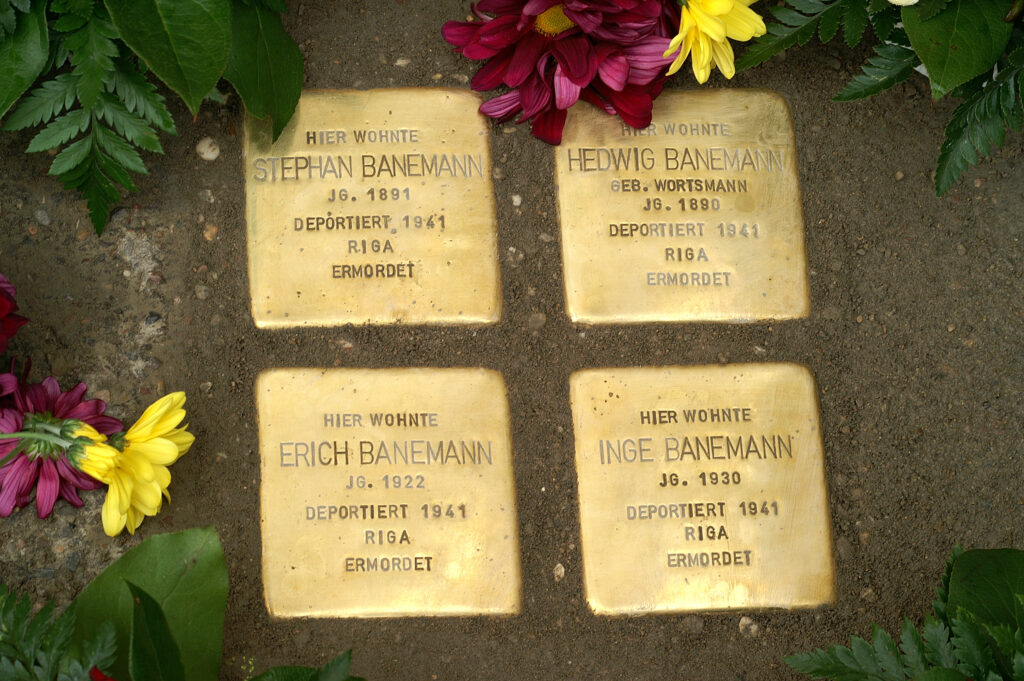
Inge Banemann’s prayer book
On 24 September 1960, Mila Baumann, a citizen of Goppingen, recorded her recollections of Inge Banemann.
“Inge Banemann was around 10 years old when she was deported with her 2 or 3 year older brother, her parents and other Jewish families from Goppingen. Pauline Barthel told me back then that the Jewish children were separated from their parents on the platform, resulting in much crying and screaming. (…)
My brother was a foreman at Schuler and although it was strictly forbidden, he had secretly taken a little book from the pile of items in the boiler house that were to be burned and showed it to me. When I told him that I had known the little Banemann girl since the days her mother took her out in her pram, he gave me the little book.
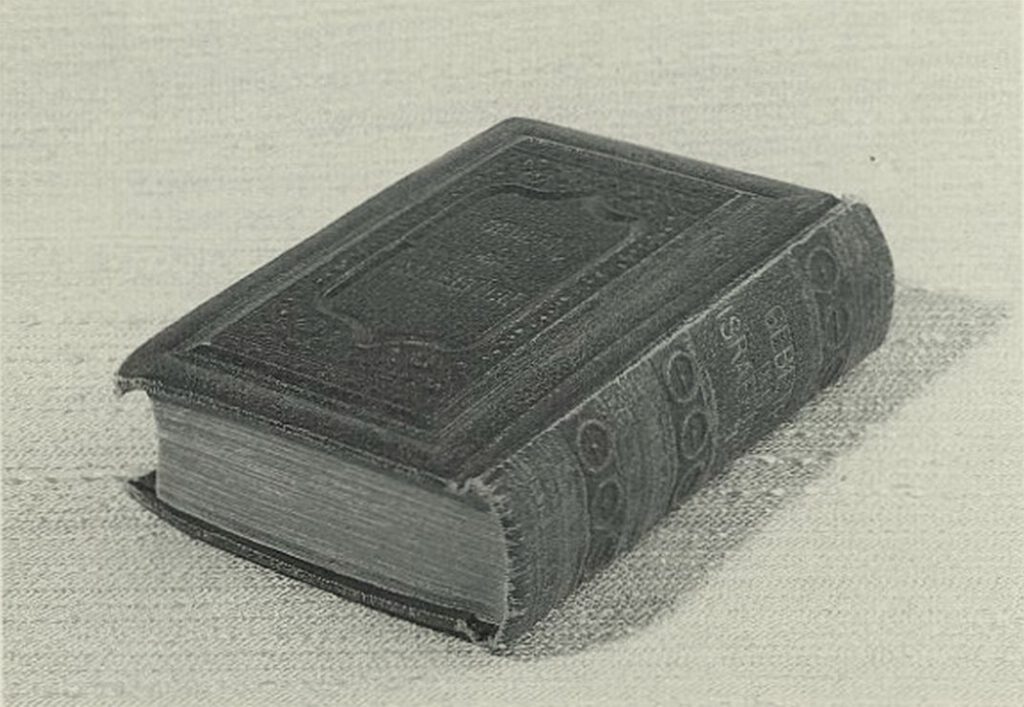
I have had it in my air raid bag all these years, hoping Inge would come back one day and I could return it to her. I asked here and there, but only ever heard that the children and their parents had been murdered.
Inge was a gentle, quiet child with flaxen hair. No-one would ever have dreamt that she was Jewish. What did she have to go through?“
Mrs. Baumann’s recollection is confirmed by this photograph of Inge wearing a summer frock.

Lots of Details about Inge
The photograph of daughter Inge on which she is wearing a light summer dress, smiling at us is well known and has been published often.
On an other photo Inge is seen within a group of children in Metzgerstraße. It was taken in front of the ‘Judenhaus’, the house where they were forced to stay.
It turned out to be more difficult to get familiar with her older brother Erich.
1929 at Chanukah the children of the Jewish community in Göppingen performed little stage-plays. A photo with the title “Prinzess Vergissmeinnicht´s Hochzeit” was taken. There Erich was shown as little dwarf. Within the same period of time another photo of Erich exists, where he is seen with his class mates. He was a student at the Evangelical Boys’ School (Evangelische Knabenschule; today Uhland Grundschule) where Karl Baun was his teacher.
We could not get hold of any photos of the parents, Hedwig and Stephan Banemann.
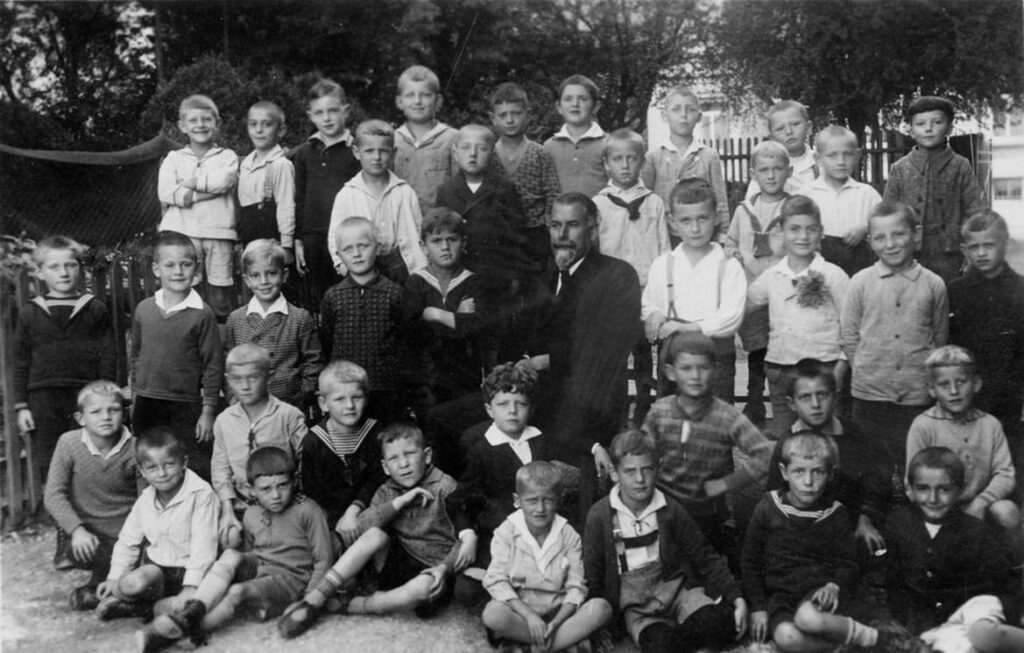
Erich Banemann 3rd. from right 2nd row
Memories
Mila Baumann’s memories, which she wrote in 1960, were often quoted. About the Banemann parents she mentioned:
“Inge’s mother was a Göppingen citizen. They lived in a house in Burgstrasse crossing Freihofstrasse, where the bookbinder Dittus is located today. She (Hedwig Baumann-kmr) was a very pretty girl and later a very pretty woman. Mr. Banemann wasn’t originally from here, blond, didn’t look Jewish. They lived next to her parents’ house in the big house which is now the public health office.”
Company Josef Einstein & Sons
The information out of Mila´s memories about the above mentioned properties was certainly correct. The house at Burgstraße 12 (“Dittus”) and the duplex at Burgstraße 14/16 both belonged to the Banemann / Wortsmann / Einstein family. The requirement for owning a house or property was a successful running company. In this case it was the company “Felle und Pelzwaren Josef Einstein & Söhne” (Furs by Josef Einstein and Sons), which was founded by Hedwig Banemann’s grandparents Josef and Jette Einstein in 1867.
Josef was citizen in Jebenhausen and was a furrier by profession. In 1873 he moved his store to Göppingen and bought the above-mentioned house at the conjunction Burgstraße / Freihofstraße. It even might be that he himself had built the house.
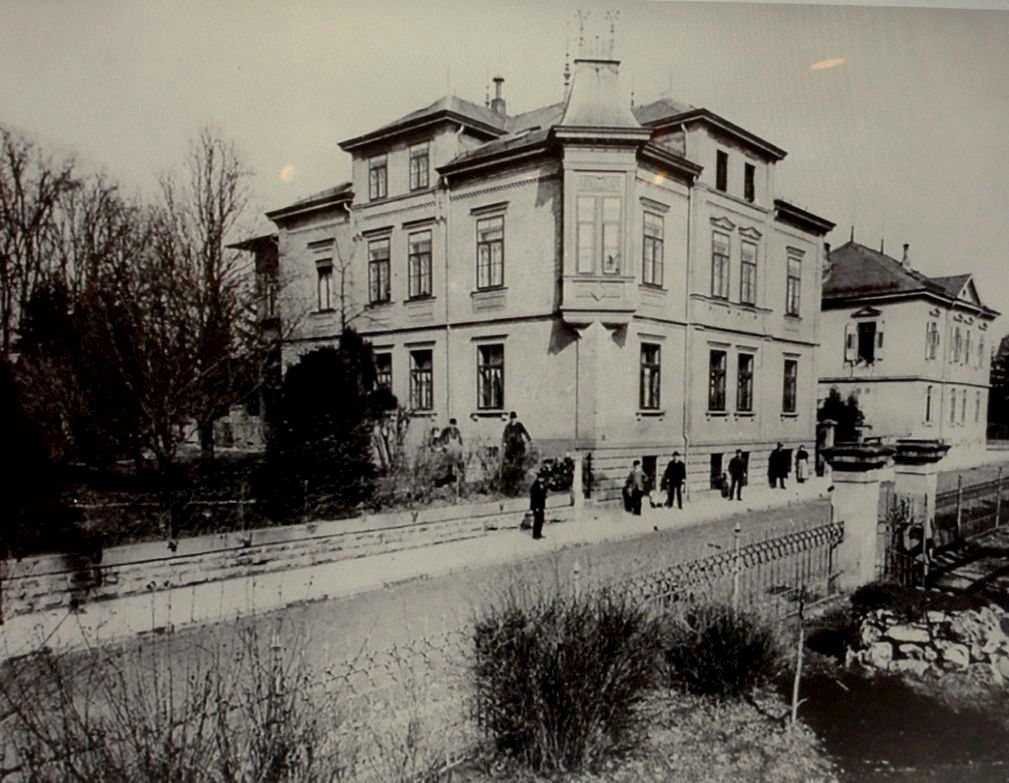
The couple’s sons were Adolph and Alfred, their daughter was named Julie. In 1889 she married Mr. Nathan Wortsmann from Burghaslach in Bavaria.
Nathan Wortsmann and his brother-in-law, Alfred Einstein, joined the company. Alfred’s younger brother Adolph soon took his place.
After the founder Joseph Einstein died in 1898, Adolph Einstein and Nathan Wortsmann took over full responsibility. The business probably prospered in the last decade before World War I started. In 1908 the duplex at Burgstrasse 14/16 was built and across the street a storage building was bought.
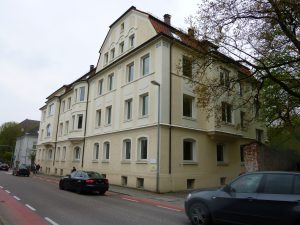
Two deaths were probably the reason that the business declined. Adolph Einstein died in 1916, his brother-in-law and business partner Nathan Wortsmann two years later. The widows Karola Einstein and Julie Wortsmann took over the company after World War I at an economically difficult time.
Hedwig and Stephan Banemann: Beaded Bags and Moleskin
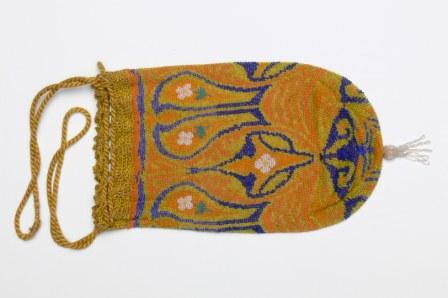
Julie’s daughter Hedwig got involved in the business too. 1916 she began to make hand-knitted beaded bags – a form of art quite common in Göppingen. She still continued her handcraft after marrying Stephan Banemann in 1921.
Stephan Banemann was born in the Franconian city of Burgkunstadt in 1891. In 1921, the same year that he married Hedwig, he became partner in the family´s fur business. In 1926 Josef (Joe) Einstein, son of late Adolph Einstein, joined him to help.
Approximately in 1923 Josef Banemann learned about the abysmal depths of his new job, when he was fined 5000 Marks for violating the mole protection law. What was this all about? Stephan Banemann sent out 6000 flyers that, among other things, detailed the conditions for purchasing mole skins. He innocently used the same promotional literature that the company had used the year before – not familiar with the mole protection law from 1920.
Conjugal Bliss (?)
However this setback did not seriously disrupt their marital bliss – in 1922 their son Erich Siegfried was born and their daughter Inge Gudrun in 1930.
How did the Banemann family live at that time? Ms. Frida Spindler who started working as a housekeeper for the Banemanns in May 1933 remembered the affluence in the household and the civilized and friendly atmosphere. Religion didn’t play a big role in the family and they seldom went to the synagogue. The family socialized with the Heimann and the Guggenheim families. Lilo Guggenheim remembered boring Sunday afternoons where the children had to join their parents on the promenades.
Dr. Wolfgang Esslinger, who grew up in the neighborhood, remembered the Banemanns as rather poor. He often observed Erich pulling a wagon full of packages with leather goods or skins to the post office. He especially remembered the situation when the company went bankrupt. The Banemanns offered to sell Mr. Esslinger’s father a piece of land and the deal went through. Unfortunately it hasn’t been possible to determine the exact time that this took place so that the question of if and when so, then what role the Nazi laws played in this transaction remains unclear.
Erich Banemann visited the official Primary School. In 1936, when school started for his little sister Inge too, the situation tightened up. Jewish children often got bullied of their ‘Aryan’ mates. Besides of that the curriculum confronted them with anti-Semitic ideology. So the Jewish community founded a comparable school of general education for their Jewish offspring. The school was located within the Rabbi’s house in Freihofstrasse 46. The classmate of Inge, Beate Dörzbacher, kept a farewell present with the signature of Inge, confirming that she indeed had been a scholar to that new invented school.

In early 1937 a tragedy happened.
Hedwig Banemann’s mother Julie Wortsmann took her own life. The Nazi hate sheet “Flammenzeichen” scoffed about it in January 1937: “The old junk collector and Jewess Wortsmann recently fell into the water on a cold day in January and accidentally drowned.”
Night of the Pogrom
The next terrifying date for the family was certainly November 9, 1938. We read in Mrs. Baumann’s memories: “On a November night in 1938 Mr. Banemann was severely mistreated; it was hardly 30 steps from the synagogue to his house. On Monday after that night I saw Mrs. Banemann on the street. She was completely disfigured and looked like a madwoman.” It was deducible that Mrs. Banemann was also physically abused that night. The question arises whether Mr. and Mrs. Banemann suffered more than other Jews from the Nazi terror during the Pogrom Night.
Stephan and Erich Banemann are neither mentioned in the Goeppingen documents nor in the lists of Dachau Concentration Camp. It could well be that Stephan was so seriously harmed at the Pogrom – Night that he was not able to be custodied for imprisonment. A similar case of another Jewish family elsewhere is known and documented.
After the Pogrom – Night the Nazi government issued numerous anti-Jewish ordinances including one to “eliminate Jews from economic life”. The last Jewish inhabitant of Burgstrasse 14 was Karola Einstein, widow of Adolph Einstein and the last inhabitant of Burgstrasse 16 was Stephan Banemann. In 1939 the financial ministry of Württemberg, “Staatsrentamt Ulm” confiscated the buildings in Burgstraße 14 and 16.
The building of Burgstrasse 12 had already been sold in 1936 to family Dittus.
1938 Stephan Banemann and his son Erich were forced to work in a factory in Stuttgart. Although the Banemann family had lost their property, they could still stay within their previous home in Burgstrasse 16 in Göppingen by renting it.
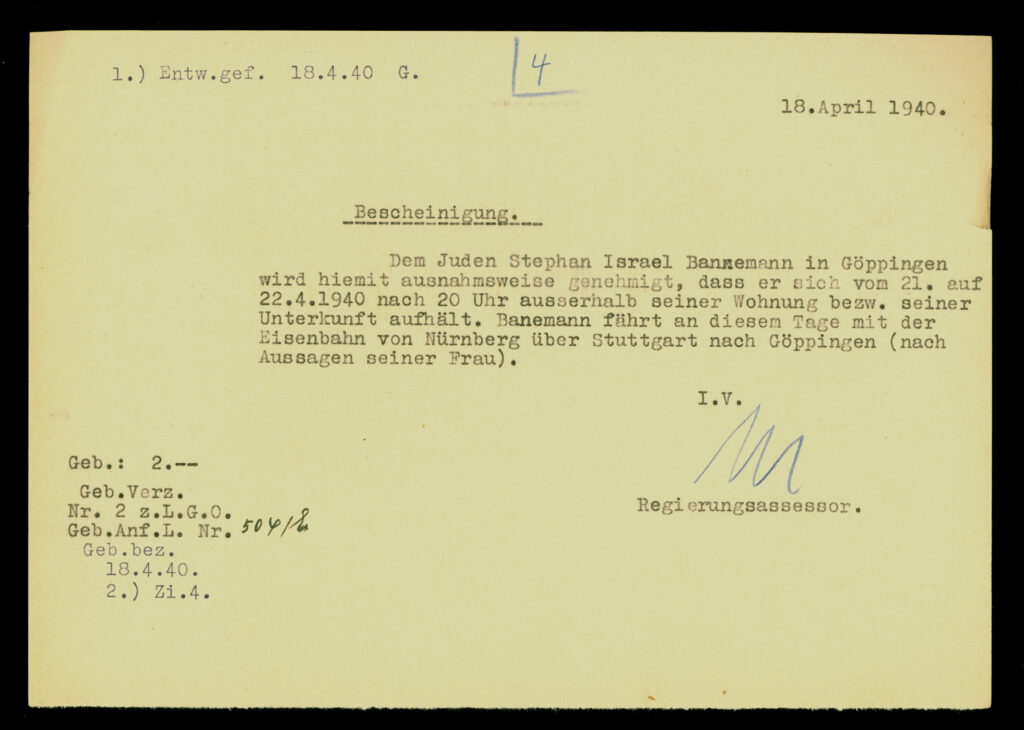
of a Jewish German in 1940. There were relatives living in Nuremberg…
1940 Mr. and Mrs. Fetzer with five children moved into the apartment above the Banemanns. Mr. Wilhelm Fetzer remembers stories his mother told, including how the renters in the ground floor heckled her, “don’t talk to the Jews!” Mrs. Fetzer didn’t listen or give in and after that she found unkind warnings in the mailbox and under her door mat.
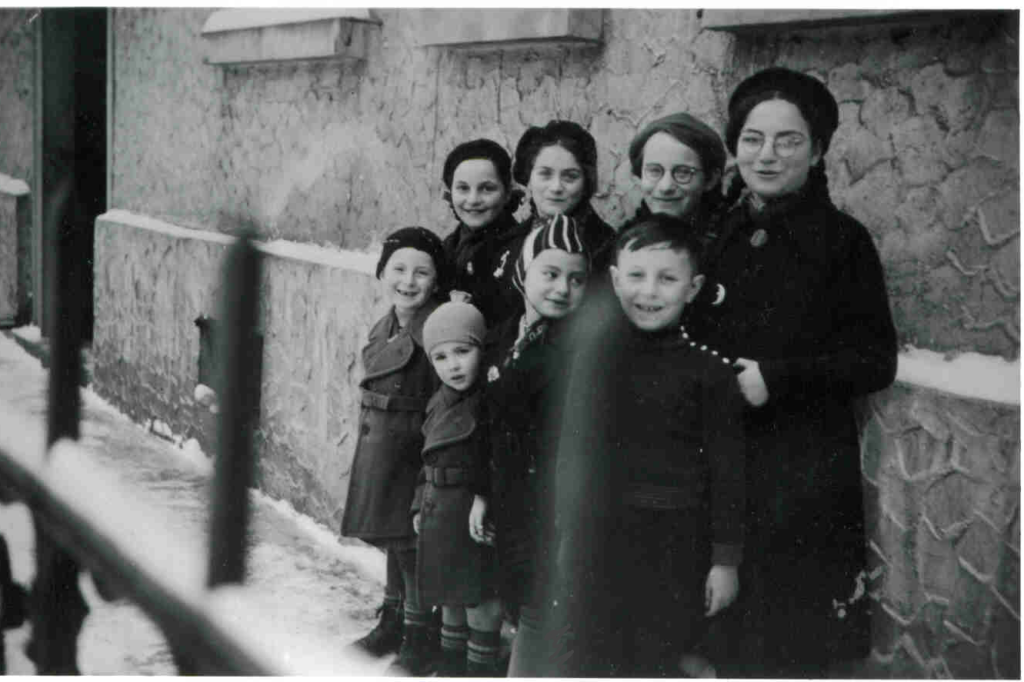
in front of the ‘Judenhaus’ Metzgerstr. 16 in late 1941
Because of a Nazi directive from 1935 which forbid “Aryan” domestics from working for Jewish families, Mrs. Spindler, the Christian housekeeper, had to quit working for the Banemann family. But Mrs. Spindler secretly met Mrs. Banemann in a store in Göppingen, Haug Home Textiles (Aussteuerhaus) to support her by giving food to help the family get by in time of utter need. The owner, Elisabeth Haug, tolerated these secret meetings. Mrs. Banemann always had to cover her Yellow Star with her handbag.
Was there no opportunity for the family to flee Germany? Mrs. Spindler remembered that they wanted to immigrate to America, but they couldn’t get a guarantor. The family had asked her if she had any relatives in America. Unfortunately in this regard Mrs Spindler couldn’t be of help.
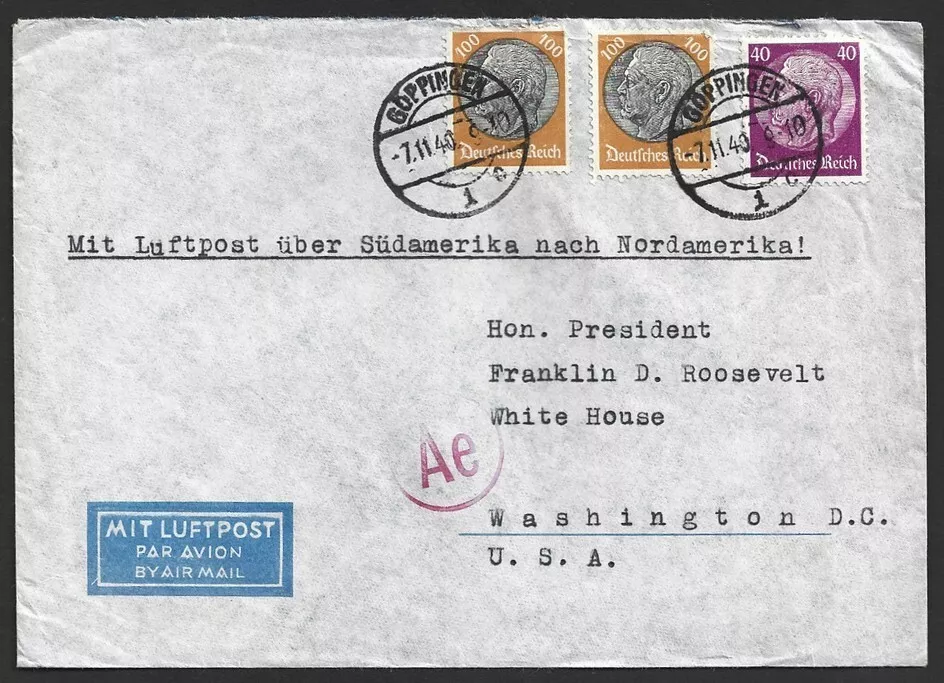
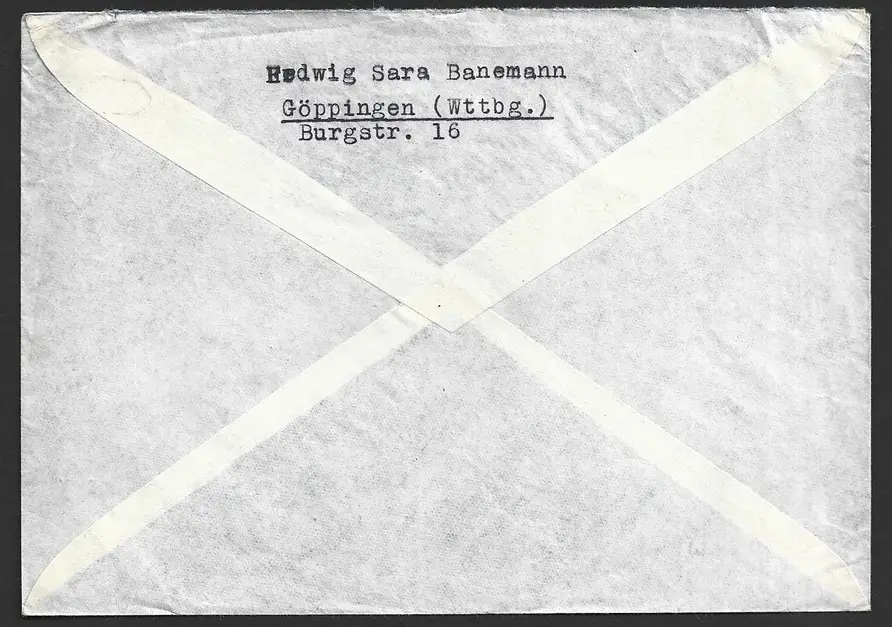
The envelope of a letter that Hedwig Banemann sent to the American president in 1940 was kindly provided to us by British philatelist Gunnar Jessen, who was able to add the following:
The round stamp with the letters AE indicates that the letter was registered by a German censor, but since no seal is visible, the censor will not have opened the letter. The letter postage means that Hedwig Banemann wanted to send the letter to the USA via South America (which is more expensive in terms of postage), thus avoiding British censorship in Bermuda and, above all, the associated delay. The letter comes from an auction with other letters addressed to President Roosevelt. These could have come from the sale of Roosevelt’s collection, who was a stamp collector. It is therefore not unlikely that Mrs. Banemann’s letter actually reached the addressee. The contents of the letter have been lost, but the envelope alone is a sign of the desperate hope of a woman from Göppingen who experienced the brutality of the Nazi regime on the night of the pogrom and feared for the lives of her family.
Deportation to Riga
In the middle of November 1941 the “deportation of the Jews” was geared up in Württemberg – “deportation of the Jews” was the code name under which robbery and murder of the Jews was planned. Mr. Fetzer remembered that Nazi officials forced their way into the Banemanns apartment prior to the deportation so that they could see what spoils were waiting for them. Frida Spindler also remembered the farewell. “My last visit in November 1941 was on the evening before their deportation. Mrs. Banemann has already gotten a mattress for each family member ready. But as far as I know they had to leave the mattresses behind the next day.” Erich, Inge, Hedwig and Stephan Banemann had to leave their apartment on November 27th. Their possessions were expropriated. Passing through the ‘collection points’ Schillerschule (Göppingen) and Killesberg (Stuttgart) they were deported to Riga by train with others from Göppingen on December 1st. Already the conditions on the train were life threatening. The camp ‘Jungfernhof’ near Riga was a site for murder. Cooped up in trucks, the deportees were driven to the forest Bikernieki in March 1942 and thousands were shot.
Richard Fleischer had been friends with Erich Banemann in Göppingen. Richard was the only one who survived the deportation. He remembered Inge being on the deportation to Bikernieki as well.
Her parents probably were murdered at the same place.
Erich deceased later of the deprivations on the “death march” headed to the port of Klaipeda (Memel). The whole family was officially registered as “missing”.
Other relatives of the Banemanns died in German extermination camps as were Stephan Banemann’s sisters: Therese Blaubaum and her son Siegfried, Bella Liebmann and her spouse Emanuel, Karolina Wortsmann, her spouse Alfred and their daughter Susanne.
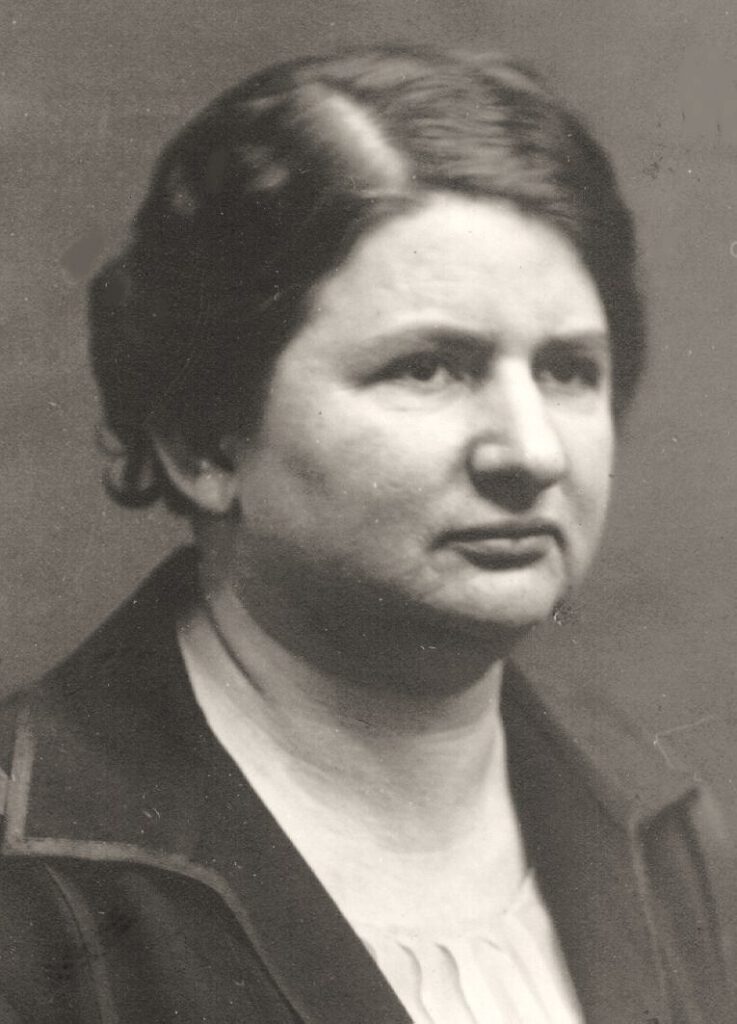
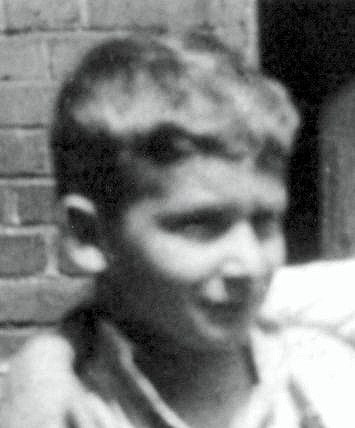
Hedwig Banemann’s aunt in law Karola Einstein, née Silbermann, who had returned to her hometown of Nuremberg in 1935 was deported to Theresienstadt in 1942. Her life ended in the extermination camp of Treblinka. Her mentally ill son Robert Einstein had been murdered in 1940 in the frame of the euthanasia murders in Grafeneck.
Of Josef and Jette Einstein’s descendants only their granddaughter Gertrud Einstein (Hedwig Banemann’s cousin) survived World War II. She died without any children in London around 1950. She as well as other relatives from the Wortsmann family applied for financial restitution after the war. In complicated legal proceedings it was explained to the family members that there were substantial tax debts on the houses at Burgstraße 14 and 16 and that the state had also settled the mortgage debt. If the houses were to be restituted, the heirs would have to pay. They accepted a compromise.
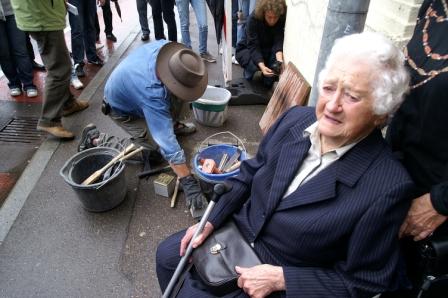
(Mrs. Spindler sitting on the right)
In May 2009 Gunter Demnig laid four Stumbling Stones for the Banemann family in front of the house at Burgstrasse 16. Students from Uhland Realschule gave report on the fate of the family and also contributed to the financing of the stones for which they took over sponsorship.
We would like to thank late Mrs. Guggenheim, late Mrs. Spindler, Mr. Fetzer and late Dr. Esslinger for the information they provided. Also we would like to thank Mrs. Auerbacher, Mrs. Greenberg (née Beate Dörzbacher), late Mr. Wascher and the Nuremberg and Goeppingen Archives for the photos provided.
(20.10.2024, kmr/ir/ww)

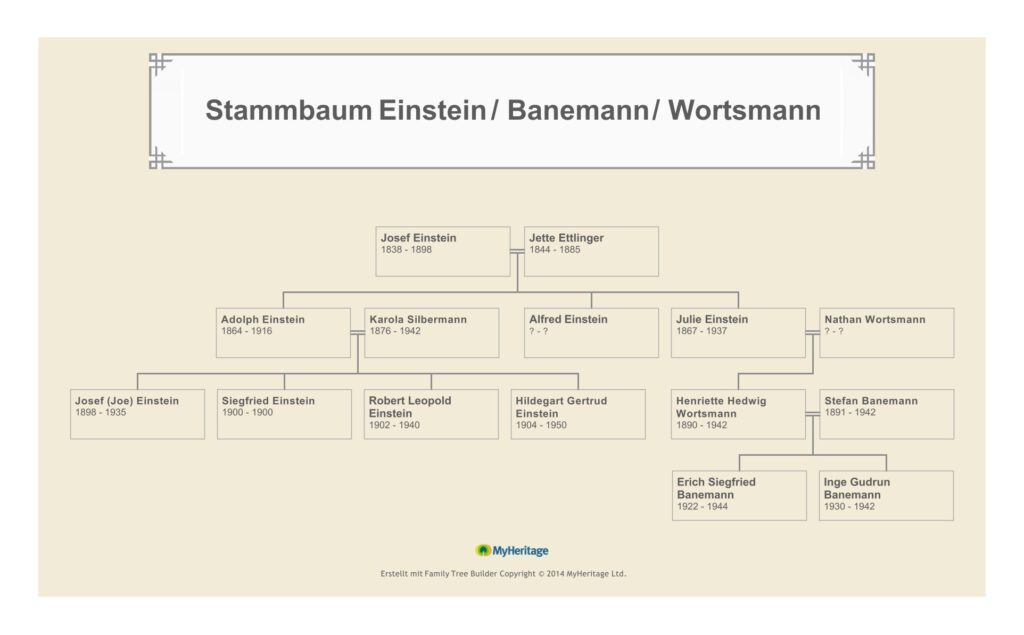
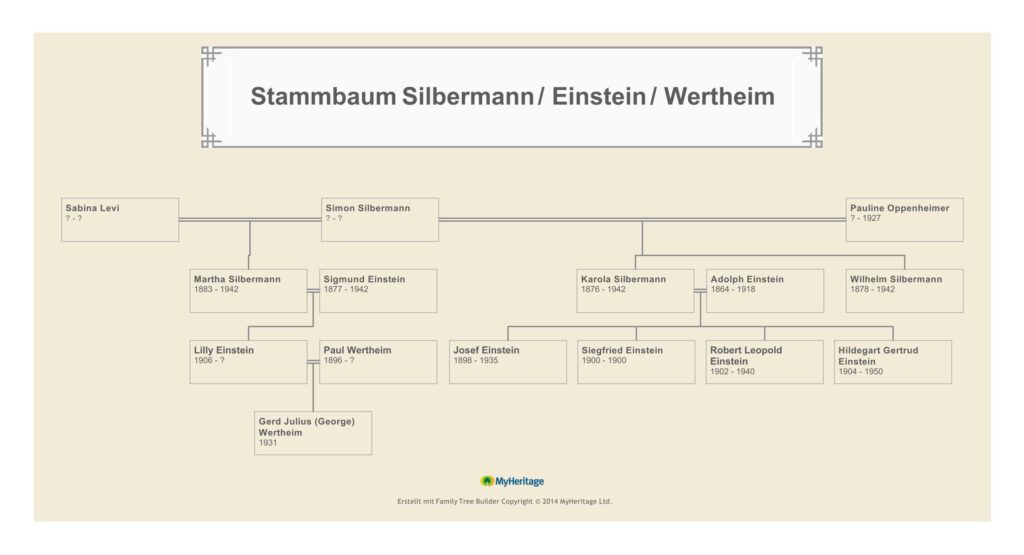


I have in my collection of philatelic material a cover mailed from Gottingen to
President Franklin D. Roosevelt, Washington U.S.A.
Posted on 7th November 1940 by Hedwig Sara Banemann
From Mila Baumann’s memories, which she wrote in 1960:
Mrs. Banemann always had to cover her Yellow Star with her handbag. Was there no opportunity for the family to flee Germany? Mrs. Spindler remembered that they wanted to immigrate to America, but they couldn’t get a guarantor. The family had asked her if she had any relatives in America. Unfortunately in this regard Mrs Spindler couldn’t be of help.
I will be pleased to email you a copy of the cover if you are interested.